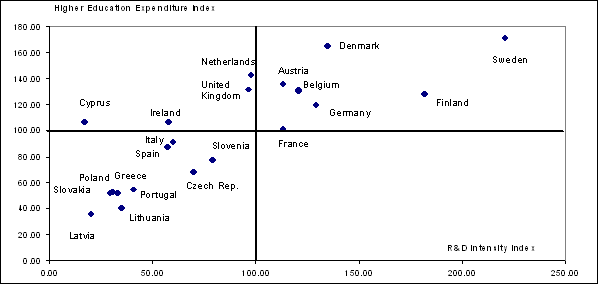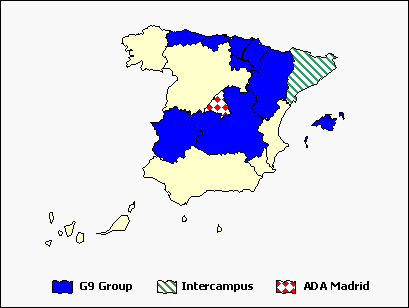| May 2006 Index | Home Page |
Editor’s Note: The Digital Divide is a global phenomenon with economic, social and political dimensions. Education agencies see information and communication technologies for education as a solution to many social and economic problems.
Networking Universities to Bridge the Digital Divide
Ana Jesús López and Rigoberto Pérez
Spain
Abstract
In recent years, attention has been focused on the digital divide, defined as “the gap between individuals, households, businesses and geographic areas at different socio-economic levels with regard both to their opportunities to access Information and Communication Technologies (ICTs) and to their use of the Internet for a wide variety of activities”.
Reduction of these gaps is considered as a strategic goal in different contexts and it is widely agreed that the education can play an important role in the achievement of this objective.
In the context of the European Union several initiatives have been launched in order to achieve “the world’s most competitive and dynamic knowledge-based economy, capable of sustainable economic growth and with more and better jobs and greater social cohesion” as approved at the Lisbon Summit (2000). Thus, the e-Learning initiative aims to boost the change from traditional education to systematic applications of Information and Communication Technologies (ICT) for the provision of flexible learning, encouraging the development of contents, services and learning environments, improving cooperation and dialogue at different spatial levels and between all the participants in the field.
In this paper we suggest the convenience of stimulating the development of university networks, describing some recent initiatives. We mainly focus on the European university context and we briefly summarize the experience of the G9 Virtual Network including nine Spanish universities.
Keywords: Information and Communication Technologies (ICT), e-learning, digital divide, Spanish G9 Virtual Network
Introduction
The development of the Information and Knowledge Society shows outstanding differences, thus leading to the existence of the so-called digital divide. According to the OECD (2001) this term refers to “the gap between individuals, households, businesses and geographic areas at different socio-economic levels with regard both to their opportunities to access information and communication technologies (ICTs) and to their use of the Internet for a wide variety of activities”.
Despite the potential benefits that can be offered by Information and Communication Technologies (ICT) developing countries face significant obstacles to ICT access due for a wide variety of reasons including technical, economic, legal and educational factors. In this paper we focus on the higher education as a strategic tool in order to bridge the existing digital divide.
According to a recent study by UNESCO (2005) one of the most significant divides between the world´s richest and poorest countries refers to the amount of schooling a child is expected to receive. A big part of this difference due to the provision of higher education. More specifically, it is found that the average length of tertiary education is more than 30 times greater in the ten countries with the highest participation rates compared to the ten with the lowest rates.
In this context, development of cooperative experiences can be very helpful since they can lead to a significant reduction in the existing gaps. In this paper is organized as follows:
Analyze the potential of university networks as a strategic tool to bridge the digital divide.
Describe the current situation, summarizing the main geographical technological and educational differences and suggesting the potential of establishing university networks.
Focus on the European context, describing its position in education and research and analyzing the role ICT can play in the challenge of developing the European Area of Higher Education.
Briefly describe the Spanish virtual networks, focusing on the G9 Virtual Network experience.
The paper ends with some concluding remarks.
Digital Divide and Education
Information and Communication Technologies (ICT) offer opportunities for developing countries to narrow the existing development gap with industrialized countries. Nevertheless significant barriers must be faced including problems of infrastructure, legal regulations, the economic situation and also educational aspects which are the main aim of this paper.
The existing differences between geographical areas have been analyzed by UNCTAD (2005) through several indicators of ICT connectivity, access and diffusion. Figure 1 summarizes some outstanding results.
| Best Position | Worst Position | Average |
OECD | United States (1) | México (73) | 23 |
East Europe and CIS | Slovenia (23) | Kyrizkistan (151) | 82 |
Latin America & Caribbean | Barbados (34) | Haití (164) | 80 |
East Asia | Singapur (9) | Vanuatu (162) | 88 |
Arab Status | Unión of Arab Emirates (20) | Djibouti (147) | 87 |
South of Asia | Maldives (50) | Bangladesh (145) | 107 |
Sub-Saharian Africa | Mauritius (52) | Guinea-Bisau (165) | 130 |
Source: UNCTAD/ITE/IPC(2005)
Figure 1. ICT diffusion rankings by geographical areas.
Since the education, and more specifically the tertiary level, can be considered both as an explicative factor of the existing gap and as a strategic tool for its reduction, a comparative analysis of some available education indicators would be advisable. More specifically, figure 2 shows the rates of access to university education and the expected length of education, which can be interpreted as the number of years that a child at age 5 can expect to be enrolled in the considered educational level. This second indicator is a particular case of the School Life Expectancy (SLE) which indicates the average duration of schooling but not the grades reached (since it computes years spent repeating grades, the SLE results overstate duration per child in countries with high repetition rates).
| Rates of Access to University Education (%) | Expected Length of Education | |||
| Total | Male | Female | University | Total |
Africa | 8 | 10 | 7 | 0.2 | 7.8 |
North America | 55 | 48 | 62 | 3.1 | 14.3 |
South America | 29 | 26 | 32 | 1.6 | 13.7 |
Asia | 16 | 18 | 15 | 1.0 | 9.9 |
Europe | 59 | 52 | 66 | 3.0 | 15.4 |
Australia | 53 | 47 | 59 | … | … |
Source: UNESCO (2005)
Figure 2. Rates of access (%) and average length of education.
Although the European position is quite positive, a more detailed analysis (see Figure 3) shows that European figures on investment in education and R&D intensity are modest when compared with the leading countries in the world. Therefore, the European Councils have stressed the importance of research and innovation by setting the goal of increasing the level of expenditure in research and development to 3% of GDP by 2010, also emphasizing the need of a better co-ordination though the European Research Area (ERA) and some related actions.
Concept | EU-15 | EU-25 | USA | Japan |
Public expenditure on education (% GDP) | 5.22 | 5.22 | 5.35 | 3.6 |
Private expenditure on education (% GDP) | 0.59 | 0.59 | 1.9 | 1.2 |
Annual expenditure on public and private higher education institutions (PPA per student) | 8562.3 | 7945.9 | 18260.1 | 10253.3 |
Annual expenditure on public and private higher education institutions compared to GDP per capita (%) | 37.1 | 36.9 | 57.8 | 43.9 |
R&D Expenditure (% GDP) | 1.93 | 1.99 | 2.76 | 3.12 |
Source: EUROSTAT, OECD (2004)
Figure 3. Expenditures on education, research and development.
Since Information and Communication Technologies have a great potential to connect people for collaboration, they can help to make knowledge more accessible and sharable for advanced teaching and learning. Focusing on the European level, according to a recent study by PLS Ramboll Management (2004) around one third of the universities in the EU-15 Member States are currently involved in co-operating with universities from other countries with the aim to offer e-learning courses jointly.
Two main levels of trans-national cooperation can be identified, respectively referred to the EU-wide co-operation and one-to-one partnership. The first one is more usual, since the European Commission has financed during the last years many cooperative projects which are summarized at the E-learning website (www.elearningeuropa.info).
Furthermore, the E-learning program 2004–2006 launched by the European Commission seeks the effective integration of Information and Communication Technologies in education and training systems in Europe, including a specific action line referred to European Virtual campuses. In fact, the priority of this line (which represents a 30% of the program funding) is to add a virtual dimension to European co-operation in higher education by encouraging the development of new organizational models for European universities (virtual campuses) and for European exchange and sharing schemes (virtual mobility).
The development of cooperative initiatives has also been encouraged in the Ibero-American University Council (2004), suggesting the convenience of agreements allowing the recognition of studies. Although most of the existing university networks in this framework are traditional some virtual experiences have also been developed, such as the Network Alive project included in the “Luis Vives” ALFA Network between the European Union and Latin America.
Since the development of virtual networks must face organizational, educational, technical and financial problems, existing institutional networks and e-learning communities can play an essential role. In order to encourage these actions (which often depend on volunteer initiatives) some incentives should be established by national governments and universities. In this way, networking between higher education institutions would lead to resource saving collaborations, the development of joint teaching offers and the improvement of quality in higher education.
European Universities at a Glance. Is there a Digital Divide?
The European Union must face the challenge of increasing its investment in education and research in order to become a more competitive and dynamic economy. In fact, the European Councils stressed the importance of research and innovation by setting the goal of increasing the level of expenditure in research and development to 3% of GDP by 2010, also emphasizing the need of a better co-ordination though the European Research Area (ERA) and some related actions. The main differences between European Member States are shown in Figure 4.

Figure 4. R&D Intensity versus Higher Education Expenditure
(Indexes, EU-25=100)
According to the information provided by Eurostat the highest R&D intensity was registered in Sweden (4.2% of GDP) then Finland (3.5%), followed by Denmark, Germany, Belgium, France and Austria, showing these countries also outstanding positions according to their expenditures on higher education. It can also be seen that in general terms the ten new Member States lag behind the European average with regard to investment in higher education and research.
Although a high level of correlation was found between both indicators (leading to a Pearson´s linear correlation coefficient of 0.82), it can be noticed that some countries show an atypical behavior. This is the case of Cyprus, whose R&D intensity level is the lowest while its expenditure in higher education exceeds the EU-25 average level.
The existence of significant differences in the current position of some European countries suggest the convenience of analyzing their strategies regarding the use of Information and Communication Technologies on higher education. In fact, this is the aim of some recent researches which are summarized in Figure 5.
| Trends IV: | Virtual Models of European Universities | Study of the e-learning suppliers market in Europe |
Reference | Reichert, S.; Tauch, C.- European University Association (2005) | PLS-Ramboll Management - European Commission (2004) | Danish Technological Institute- European Commission (2005) |
Methodology | 62 site visits to Higher Education Institutions in 29 European countries
| Survey to more than 200 European Universities. Interviews and Cluster Analysis
| Published Reports on e-learning in 26 European countries. Interviews with |
Main Findings | General acceptance of the need for reforms seems to be widespread in universities. Many of them have made efforts to incorporate Bologna issues. | Most European universities show a positive attitude towards ICT integration and e-learning, although the support and priority allocated by university management is a critical obstacle in many of them. | E-learning products and services market remain small. Higher education is the market where Open Source e-learning platforms would represent a serious competition to commercial products by 2010. |
Figure 5. Description of recent investigations on European Universities
The described investigations show some similarities, although the European University Association focuses on the implementation of the Bologna objectives across Europe, while the Study developed by the Danish Technological Institute is mainly interested in the economic aspects of e-learning. Finally, the analysis of the implementation of Information and Communication Technologies in European Universities is the main aim of the PLS-Ramboll Management investigation.
According to this last approach, some outstanding differences can be found allowing the division into four university clusters concerning their current use of ICT in the organizational and educational setting. Thus, following the study by PLS Ramboll Management, the “front-runners universities” (18%) are distinguished by their pre-eminence in all respects, including their level of co-operation with other universities and other suppliers of education.
The second cluster is defined as “co-operating universities”, which are characterized by the extensiveness of their involvement in strategic co-operation with both domestic and foreign universities and with other education suppliers. These universities (33%) are, like the front-runners, quite advanced in the integration of ICT into their campus-based teaching, but show a more limited use of e-learning courses and digital services.
“Self-sufficient universities” comprise the largest cluster, encompassing 36% of the universities. Their level of ICT integration in the organizational and educational setting is similar to that of the co-operating universities, but they engage in strategic co-operation with other universities or suppliers of education only to a minimal degree.
The remaining 15% corresponds to the “skeptical universities” which are observed to be lagging behind the rest in almost every respect. In general terms these institutions are characterized by a limited use of digital services, limited ICT integration in their on-campus teaching, and a very low proportion of e-learning courses.
On the basis of this analysis, PLS Ramboll Management has generated some recommendations at European, national and university level, mainly focusing on the dissemination of experiences and good practice, the quality assurance and assessment procedures, the design of joint degrees, the use of common metadata standards and the development of European networks.
The European dimension has also been recently stressed by the European University Association (EUA) in the Glasgow Declaration (2005) entitled “Strong Universities for a Strong Europe”, which refers to the reinforcement of the European dimension in a variety of ways, including benchmarking curricula, developing joint degrees using European tools or enhancing intercultural and multilingual skills.
A Spanish Experience. The G-9 Virtual Network
As we have previously said, existing institutional virtual networks can be very helpful in the development of European virtual campuses. In this section we describe the Spanish experience, mainly focusing on the so-called G9 Virtual Network.
The European emergent trend towards a higher level of institutional co-operation also appears in the Spanish context, as it is pointed out in some recent studies carried out by López et al. (2002) and CRUE (2004). The following table summarizes these experiences including three university networks (ADA-Madrid, Intercampus and the G9 Virtual Network) and also a cooperative alliance involving both public and private organizations.
ADA-Madrid | Intercampus | G9 Virtual Network | IUP |
U. Autónoma de Madrid; | U. Autónoma de Barcelona; | U. de Cantabria; | U. Carlos III, |
30 subjects | 48 subjects | 70 subjects | 9 Masters online |
Figure 6. Spanish Virtual Networks
The G9 Group of Universities was created in 1999 and it currently includes nine public universities located in different Spanish regions. As figure 7 shows the geographical diversity is one of the most outstanding characteristics of this network, while ADA-Madrid and Intercampus are respectively located in the regions of Madrid and Catalonia.

Figure 7. The G9 Virtual Network
During the last years the G9 Virtual Network has gradually increased the level of interaction between the involved institutions, thus adding a new dimension to the e-learning experiences (where students usually interact with the content, instructors, classmates and themselves). Several legal, academic, technical and administrative challenges have also been faced in order to guarantee the full academic recognition of the credits coursed at each of the G9 universities. At the present moment the G9 Virtual Network involves 2485 students, 70 subjects and a joint master degree is under development.
Opinions of all the agents involved in the G9 virtual network are yearly collected through online surveys. Furthermore, annual meetings are organized providing teachers, students and technical staff with an excellent opportunity for sharing their experiences.
According to the online surveys, students of the G9 Virtual Network are mainly motivated by the use of new learning methods and their flexibility and most of them consider this experience very positive. Students are connected to the Shared Virtual Network an average of three hours per week and they find the learning materials as adequate or very adequate (82.6%) of a high quality and well structured (80.4%) and available in time (71.7%). A more detailed description of the G9 Shared Virtual Network experiences can be found in Salinas et al. (2002) and López and Pérez (2005a).
In general terms students highly appreciate the tutorials and communication facilities (forum, chat, mail, video-conferences, …) and the interactive learning materials. On the other side, most of them find that the university infrastructures do not fully satisfy the e-learning requirements.
For which it refers to the near future, as Pérez (2004) points out, the G9 Virtual Networks aims to continue improving quantitatively and qualitatively its educational offering, with the incorporation of new joint master degrees, to implement common incentives for the G9 virtual teachers and tutors, to develop joint research projects in e-learning and to undertake an internationalization process, with its incorporation to both European and Latin American networks.
Concluding Remarks
The available information shows the existence of a digital divide between developing and industrialized countries. Furthermore, a significant divide is also found when analyzing the education indicators and more specifically at the university level.
Since the education can be considered both as an explicative factor of the existing gap and as a strategic tool for its reduction, it would be advisable to increase the investment on education, research and innovation also encouraging the co-operation in higher education and research.
In the European context, the E-learning program 2004-2006 includes a specific action line whose priority is to add a virtual dimension to European co-operation in higher education by encouraging the development of virtual campuses. Although this objective must face some legal, academic, technical and financial difficulties, the experience achieved by existing cooperating initiatives and virtual communities can be very helpful in this process.
The experience of Spanish G9 Virtual Network has shown the potential of the university co-operation, also suggesting the need of further efforts to improve its learning offer and the convenience of establishing international alliances with existing networks both in the European and the Latin-American contexts.
In summary, we can conclude that making university networks a widespread reality is still a challenge and it should be considered a strategic goal for the coming years, which could highly contribute to increase the quality also decreasing the existing digital divide.
References
Browetto, J. (1999): “La educación superior en iberoamérica: crisis, debates, realidades y transformaciones en la última década del siglo XX”, Revista Iberoamericana de Educación, n. 21, p.1-12.
Commission of the European Communities (2004) Challenges for the European Information Society beyond 2005, Communication from the Commission to the Council, the European Parliament, the European Economic and Social Committee and the Committee of the Regions, COM(2004), 757.
Commission of the European Communities (2005) “Progress towards the Lisbon objectives in Education and Training”, Commission Staff Working Paper, SEC(2005), 419.
CRUE (2004) Las Tecnologías de la Información y las Comunicaciones en el Sistema Universitario Español, (www.crue.org).
Danish Technological Institute (2005): Study of the e-learning suppliers “market” in Europe, Directorate General for Education and Culture, European Commission.
De Ferranti et al. (2003): “Cerrando la brecha en educación y tecnología”, Estudios del Banco Mundial sobre América Latina y el Caribe.
Dias, M.A.J. (2003): “Cooperação universitária na criação do espaço Europa-America Latina-Caribe”, II Reunião Plenária do Conselho Universitario Ibero-Americano (CUIB), Porto Alegre.
European Commission E-Learning Initiative, http://www.elearningeuropa.info
European Ministers of Education (1999): The European Higher Education Area, Joint Declaration of Bologna.
Haugen, H.; Ask, B. (2003): “The MENU project. Model for a European Networked University for e-Learning”, International Conference on Network Universities and e-Learning, Valencia.
Loaiza, R. (2003): “La Universidad virtual en Latinoamérica”, Etic@net, n. 2, p.1-12.
López, A.J.; Pérez, R. (2005a) “Learning Statistics in a Shared Virtual Campus. Summarizing a Five-Year Experience”, Instructional Technology and Distance Learning¸ vol. 2, n. 3, p. 29-40, http://www.itdl.org/
López, A.J.; Pérez, R. (2005b): “Networking Universities to bridge the European Digital Divide”, IV European Conference on E-Learning ECEL, Amsterdam.
López, A.J.; Pérez, R. (2006): “¿Pueden las redes universitarias atenuar la brecha digital? Reflexiones y experiencias”, Congreso Internacional Universidad 2006, “La universalización de la Universidad por un mundo mejor, La Habana.
López, A.J.; Pérez, R.; Mayor, M.; Vicente, M.R. (2002) “Is there a digital divide between spanish universities? A web based approach”, International Conference on Information and Communication Technologies in Education, vol. 3, p.1490-1493.
OECD (2004): Education at a Glance. OECD Indicators, http://www.oecd.org/
Pérez, R. (2004) “CVC-G9. Nueva estructura”, III Jornadas CVC-G9: e-Learning y Espacio Europeo de Educación Superior”, Bilbao.
PLS Ramboll Management (2004): Studies in the context of the E-Learning Initiative: Virtual Models of European Universities, European Union Commission, DG Education and Culture.
Reichert, S.; Tauch, C. (2005) Trends IV: European Universities implementing Bologna, European University Association.
Salinas, J. et al. (2002): “Red de Servicios y Estructuras Comunes en el Campus Virtual Compartido del G9 de Universidades”, Informe Final del Proyecto EA2002-0109, Programa de Estudios y Análisis de la Secretaría de Estado de Universidades.
UNCTAD/ITE/IPC (2005): The Digital Divide: ICT Development Indices 2004, United Nations.
UNDP (2001): Human Development Report 2001: Making New Technologies work for Human Development, Oxford University Press, New York.
UNESCO (2005): Education Trends in Perspective - Analysis of the World Education Indicators, UNESCO Institute for Statistics, http://www.uis.unesco.org/
About the Authors
Ana Jesús López | Ana Jesús López is Professor of Statistics and Econometrics at University of Oviedo, Spain. She is Ph.D. in Economics at the University of Oviedo (1991) and Bachelor in Economic Sciences at the same University (1986). Her research activities are related to three fields: the measurement of economic inequality, the regional modelling and forecasting and the socio-economic impact of the Information and Communication Technologies (ICTs), mainly the e-learning. She has been involved in several research projects and she is author of several publications in international and Spanish journals. Ana Jesús López Tel: 34 985103759 Mail: anaj@uniovi.es |
Rigoberto Pérez | Rigoberto Pérez is Professor of Statistics and Econometrics at University of Oviedo, Spain. He is Ph.D. in Economics at the University of Oviedo (1985) and Bachelor in Mathematics at the University of Santiago de Compostela (1978). Professor Pérez has published several books and articles in international and Spanish journals. He has been involved in several research projects, and has supervised seven Doctoral Dissertations and eight Post-Graduate Dissertations. In his current position of Director of the Innovation Center of the University of Oviedo and the Shared Virtual Campus of the G9 Group (including nine Spanish Universities) he is also involved in several projects dealing with the ICTs impact, the e-learning and the development of suitable quality indicators. Rigoberto Pérez, Tel: 34 985103748 Mail: rigo@uniovi.es |

